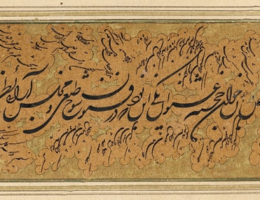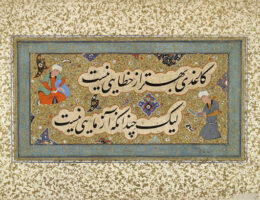IRAN ART EXHIBITION: INTRODUCING TYPES OF CALENDAR AND ITS SYSTEM
A calendar is a system of organizing days. This is done by giving names to periods of time, typically days, weeks, months and years. A date is the designation of a single, specific day within such a system. A calendar is also a physical record (often paper) of such a system. A calendar can also mean a list of planned events, such as a court calendar or a partly or fully chronological list of documents, such as a calendar of wills.
Periods in a calendar (such as years and months) are usually, though not necessarily, synchronized with the cycle of the sun or the moon. The most common type of pre-modern calendar was the lunisolar calendar, a lunar calendar that occasionally adds one intercalary month to remain synchronized with the solar year over the long term.
Etymology
The term calendar is taken from kalendae, the term for the first day of the month in the Roman calendar, related to the verb calare ‘to call out’, referring to the “calling” of the new moon when it was first seen. Latin calendarium meant ‘account book, register’ (as accounts were settled and debts were collected on the calends of each month). The Latin term was adopted in Old French as calendier and from there in Middle English as calender by the 13th century (the spelling calendar is early modern).
History
The course of the sun and the moon are the most salient natural, regularly recurring events useful for timekeeping, thus in pre-modern societies worldwide lunation and the year were most commonly used as time units. Nevertheless, the Roman calendar contained remnants of a very ancient pre-Etruscan 10-month solar year. The first recorded physical calendars, dependent on the development of writing in the Ancient Near East, are the Bronze Age Egyptian and Sumerian calendars.
The Vedic India developed a sophisticated time keeping methodology and calendars for Vedic rituals.
A large number of Ancient Near East calendar systems based on the Babylonian calendar date from the Iron Age, among them the calendar system of the Persian Empire, which in turn gave rise to the Zoroastrian calendar and the Hebrew calendar.
A great number of Hellenic calendars developed in Classical Greece, and in the Hellenistic period gave rise to both the ancient Roman calendar and to various Hindu calendars. According to Yukio Ohashi, Vedanga field developed from actual astronomical studies in ancient Vedic Period and not derived from other cultures.
Calendars in antiquity were lunisolar, depending on the introduction of intercalary months to align the solar and the lunar years. This was mostly based on observation, but there may have been early attempts to model the pattern of intercalation algorithmically, as evidenced in the fragmentary 2nd-century Coligny calendar.
IRAN ART EXHIBITION: The Roman calendar was reformed by Julius Caesar in 46 BC. The Julian calendar was no longer dependent on the observation of the new moon but simply followed an algorithm of introducing a leap day every four years. This created a dissociation of the calendar month from the lunation.
The Islamic calendar is based on the prohibition of intercalation (nasi’) by Muhammad, in Islamic tradition dated to a sermon held on 9 Dhu al-Hijjah AH 10 (Julian date: 6 March 632). This resulted in an observation-based lunar calendar that shifts relative to the seasons of the solar year.
Modern reforms
The first calendar reform of the early modern era was the Gregorian calendar, introduced in 1582 based on the observation of a long-term shift between the Julian calendar and the solar year.
There have been several modern proposals for reform of the calendar, such as the World Calendar, International Fixed Calendar, Holocene calendar, and, recently, the Hanke-Henry Permanent Calendar. Such ideas are mooted from time to time but have failed to gain traction because of the loss of continuity, massive upheaval in implementation, and religious objections.
Systems
A full calendar system has a different calendar date for every day. Thus the week cycle is by itself not a full calendar system; neither is a system to name the days within a year without a system for identifying the years.
The simplest calendar system just counts time periods from a reference date. This applies for the Julian day or Unix Time. Virtually the only possible variation is using a different reference date, in particular, one less distant in the past to make the numbers smaller. Computations in these systems are just a matter of addition and subtraction.
IRAN ART EXHIBITION: Other calendars have one (or multiple) larger units of time.
Calendars that contain one level of cycles:
• week and weekday – this system (without year, the week number keeps on increasing) is not very common
• year and ordinal date within the year, e.g., the ISO 8601 ordinal date system
Calendars with two levels of cycles:
• year, month, and day – most systems, including the Gregorian calendar (and its very similar predecessor, the Julian calendar), the Islamic calendar, the Solar Hijri calendar and the Hebrew calendar
• year, week, and weekday – e.g., the ISO week date

IRAN ART EXHIBITION: Cycles can be synchronized with periodic phenomena:
• Lunar calendars are synchronized to the motion of the Moon (lunar phases); an example is the Islamic calendar.
• Solar calendars are based on perceived seasonal changes synchronized to the apparent motion of the Sun; an example is the Persian calendar.
• Lunisolar calendars are based on a combination of both solar and lunar reckonings; examples include the traditional calendar of China, the Hindu calendar in India and Nepal, and the Hebrew calendar.
• The week cycle is an example of one that is not synchronized to any external phenomenon (although it may have been derived from lunar phases, beginning anew every month).
Very commonly a calendar includes more than one type of cycle or has both cyclic and non-cyclic elements.
Most calendars incorporate more complex cycles. For example, the vast majority of them track years, months, weeks and days. The seven-day week is practically universal, though its use varies. It has run uninterrupted for millennia.
Solar
Solar calendars assign a date to each solar day. A day may consist of the period between sunrise and sunset, with a following period of night, or it may be a period between successive events such as two sunsets. The length of the interval between two such successive events may be allowed to vary slightly during the year, or it may be averaged into a mean solar day. Other types of calendar may also use a solar day.
Lunar
IRAN ART EXHIBITION: Not all calendars use the solar year as a unit. A lunar calendar is one in which days are numbered within each lunar phase cycle. Because the length of the lunar month is not an even fraction of the length of the tropical year, a purely lunar calendar quickly drifts against the seasons, which do not vary much near the equator. It does, however, stay constant with respect to other phenomena, notably tides. An example is the Islamic calendar. Alexander Marshack, in a controversial reading, believed that marks on a bone baton (c. 25,000 BC) represented a lunar calendar. Other marked bones may also represent lunar calendars. Similarly, Michael Rappenglueck believes that marks on a 15,000-year-old cave painting represent a lunar calendar.
Lunisolar
A lunisolar calendar is a lunar calendar that compensates by adding an extra month as needed to realign the months with the seasons. Prominent examples of lunisolar calendar are Hindu calendar and Buddhist calendar that are popular in South Asia and Southeast Asia. Another example is the Hebrew calendar, which uses a 19-year cycle.






